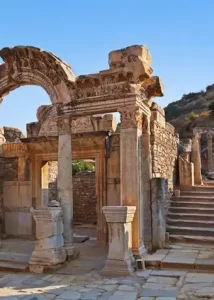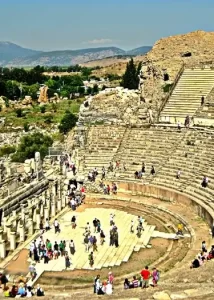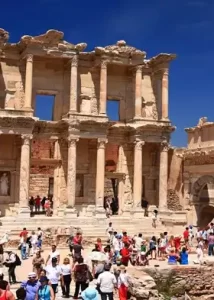Tour Details:
Ephesus Tour is daily group tour includes domestic flights, licenced tour guide, lunch in tour, museum tickets in tour program and hotel pick-drop off from city center hotels.
Pick up from city center hotels and transfer to Istanbul Airport for Ephesus flight. You will meet with our welcomer and transfer to Ephesus to join tour.
Tour Details:
- Isabey Mosque
- House of Virgin Mary
- Ephesus
- Temple of Artemis
After the tour, you will be transfer to Izmir airport and fly to Istanbul. Our driver will meet with you at airport and drop you off at city center hotels.
Travel by Turkey higly recommend Ephesus Tour if you didnt visit Ephesus. You can save money and time with our tarvel agency.
Note: Please ask for the price.
Daily Ephesus Tour
What is included?
- Pick up-drop off from city center hotels
- Domestic flights
- Airport transfers
- Licenced tour guide
- Museum tickets in program
- Lunch
What is not included?
- Self expenses
- Drinks
- Tips
What to Expect?
Isabey Mosque:
The İsa Bey Mosque, located in Selçuk, near the ancient city of Ephesus in Turkey, is one of the oldest and most significant historical mosques in Anatolia. Built between 1374 and 1375 by the architect Şamlı Ali Çavuş, the mosque is renowned for its impressive architectural design, historical importance, and intricate decorations, reflecting the Seljuk and early Ottoman architectural styles.
The İsa Bey Mosque features a rectangular plan with a large courtyard, a central dome supported by four massive columns, and a minaret with a unique cylindrical shape and conical top. The mosque’s exterior facade showcases intricate stone carvings, geometric patterns, and ornate decorations, while the interior is adorned with beautiful tilework, calligraphy, and motifs that reflect the artistic and cultural influences of the period.
Inside the mosque, visitors can admire the mihrab (prayer niche), mimbar (pulpit), and other architectural elements adorned with exquisite decorations, inscriptions from the Quran, and geometric patterns that symbolize spiritual significance, artistic creativity, and historical legacy. The serene ambiance, historical significance, and architectural beauty of the İsa Bey Mosque create a captivating atmosphere, inviting visitors to explore, admire, and appreciate the rich heritage, craftsmanship, and cultural traditions that define this iconic landmark.
Furthermore, the İsa Bey Mosque’s location near the ancient city of Ephesus, a UNESCO World Heritage Site, offers visitors the opportunity to explore other historical and archaeological attractions, including ancient ruins, temples, theaters, and monuments dating back to the Greek, Roman, and Byzantine periods. Together, the İsa Bey Mosque and the nearby archaeological sites contribute to the region’s cultural richness, historical significance, and tourism appeal, making it a must-visit destination for travelers exploring Turkey’s diverse landscapes, ancient civilizations, and architectural wonders.
House of Virgin Mary:
The House of the Virgin Mary, located near the ancient city of Ephesus in Turkey, is a significant pilgrimage site and religious landmark revered by Christians worldwide. According to tradition and popular belief, this modest stone house on Mount Koressos is where the Virgin Mary spent her last years after the Crucifixion of Jesus Christ.
The site’s association with the Virgin Mary dates back to the visions of Blessed Anne Catherine Emmerich, a German nun, in the early 19th century. Based on her detailed descriptions of the Virgin Mary’s life post-Crucifixion, the House of the Virgin Mary was discovered and later recognized as a place of pilgrimage for Christians and visitors seeking spiritual reflection, prayer, and contemplation.
The House of the Virgin Mary is a tranquil and sacred place characterized by its serene surroundings, natural beauty, and spiritual ambiance. Visitors can explore the stone house, chapel, and surrounding gardens, participate in religious services, and pay their respects at the sacred site, which has been recognized by multiple popes and visited by pilgrims, dignitaries, and tourists from around the world.
Moreover, the House of the Virgin Mary’s proximity to the ancient city of Ephesus, a UNESCO World Heritage Site, offers visitors the opportunity to explore archaeological ruins, historical landmarks, and cultural attractions dating back to the Greek, Roman, and Byzantine periods. Together, these sites provide a unique blend of spiritual, historical, and cultural experiences, making the House of the Virgin Mary and Ephesus region a significant destination for pilgrims, historians, and travelers interested in exploring Turkey’s rich heritage, religious traditions, and ancient civilizations.
Ephesus:
Ephesus, located near the modern-day town of Selçuk in Turkey’s Izmir Province, is one of the most well-preserved ancient cities in the Mediterranean region and a UNESCO World Heritage Site. Founded as an ancient Greek city, Ephesus flourished during the Classical Greek, Hellenistic, Roman, and Byzantine periods, becoming a prominent center of trade, culture, and spirituality in the ancient world.
Ephesus is renowned for its impressive archaeological ruins, monumental structures, and historical landmarks that reflect its rich history, architectural achievements, and cultural significance. Some of the most notable attractions within the archaeological site of Ephesus include:
- Library of Celsus: This iconic structure is one of the best-preserved ancient Roman buildings, featuring an impressive facade adorned with columns, statues, and intricate carvings. The Library of Celsus served as a monumental tomb for the Roman senator Tiberius Julius Celsus Polemaeanus and housed over 12,000 scrolls.
- The Grand Theater: Dating back to the Hellenistic period with Roman modifications, the Grand Theater is one of the largest ancient theaters in the world, capable of accommodating up to 25,000 spectators. This well-preserved theater hosted theatrical performances, assemblies, and public gatherings, reflecting the city’s cultural and social significance.
- Temple of Artemis: Although only a few ruins remain today, the Temple of Artemis was one of the Seven Wonders of the Ancient World. Dedicated to the Greek goddess Artemis, this monumental temple was a significant religious and cultural center in antiquity.
- The Terrace Houses: Located on the slopes of Bulbul Mountain, the Terrace Houses of Ephesus are well-preserved residential complexes showcasing exquisite mosaics, frescoes, and architectural details that provide insights into the daily lives, wealth, and craftsmanship of Ephesian elites.
- Agora: The ancient Agora served as the commercial, political, and social hub of Ephesus, featuring a marketplace, administrative buildings, and public spaces where citizens gathered for commerce, discussions, and civic activities.
In addition to its archaeological treasures, Ephesus offers visitors a fascinating glimpse into ancient Greek and Roman civilizations, architectural marvels, religious practices, and cultural achievements. The site’s well-preserved ruins, historical significance, and proximity to other attractions such as the House of the Virgin Mary make Ephesus a must-visit destination for travelers, historians, and archaeology enthusiasts exploring Turkey’s rich heritage, ancient civilizations, and cultural landmarks.
Temple of Artemis:
The Temple of Artemis, also known as the Temple of Diana in ancient times, was a magnificent ancient Greek temple dedicated to the goddess Artemis, located near the city of Ephesus in present-day Selçuk, Turkey. Recognized as one of the Seven Wonders of the Ancient World due to its grandeur, architectural significance, and historical importance, the Temple of Artemis was a monumental structure that served as a center of worship, pilgrimage, and cultural significance in antiquity.
The original temple was commissioned by King Croesus of Lydia and completed around 550 BCE, although the site underwent several reconstructions, expansions, and renovations over the centuries due to various reasons, including natural disasters, invasions, and religious transformations. The temple’s architectural design and dimensions were awe-inspiring, featuring a massive footprint, numerous columns, intricate carvings, and decorative elements that reflected the Greek Ionic style and artistic craftsmanship of the period.
The Temple of Artemis was not only a religious sanctuary dedicated to the goddess of hunting, wilderness, and fertility but also a symbol of prosperity, power, and prestige for the city of Ephesus and the broader Greek world. The temple complex encompassed a sacred precinct, altar, statue of Artemis, treasuries, and various auxiliary buildings, reflecting the site’s importance as a religious, cultural, and economic center in the ancient Mediterranean region.
Despite its significance and grandeur, the Temple of Artemis suffered destruction, looting, and eventual abandonment over time, with the final remnants disappearing due to earthquakes, floods, and the passage of time. Today, only a few scattered ruins, fragments, and historical descriptions remain to commemorate the temple’s existence, with the majority of its architectural elements, sculptures, and artifacts preserved in museums, private collections, and archaeological repositories worldwide.
Nevertheless, the legacy of the Temple of Artemis endures as a testament to ancient Greek civilization, architectural achievements, religious practices, and cultural contributions to the development of Western civilization. Its inclusion as one of the Seven Wonders of the Ancient World and continued recognition by historians, archaeologists, and scholars underscores its enduring significance, historical importance, and cultural impact within the context of antiquity and the broader narrative of human history.
Cancellation Policy
- If you cancel up to 7 days in advance of the experience, you will receive half refund.
- When you cancel less than 7 days before start time, you will not be refunded.
- If you want any changes less than 3 days before start time, it will not be accepted.
- If the tour canceled due to poor weather, we will offer a different date or a full refund.





